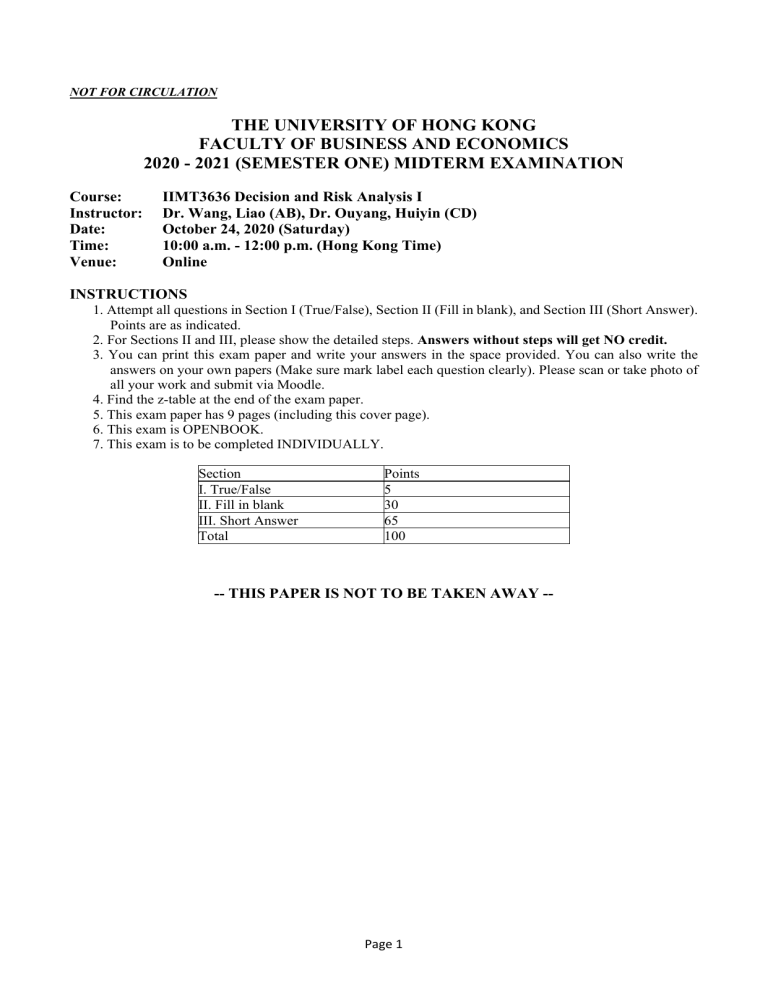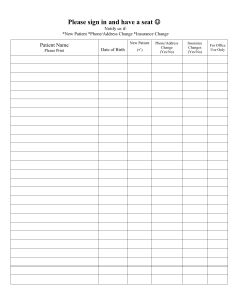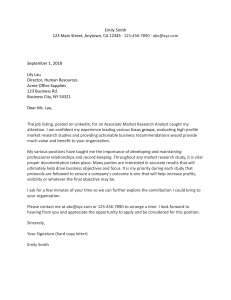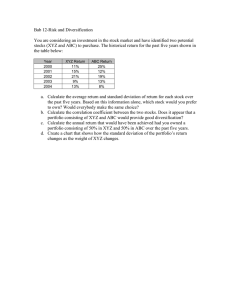
NOT FOR CIRCULATION THE UNIVERSITY OF HONG KONG FACULTY OF BUSINESS AND ECONOMICS 2020 - 2021 (SEMESTER ONE) MIDTERM EXAMINATION Course: Instructor: Date: Time: Venue: IIMT3636 Decision and Risk Analysis I Dr. Wang, Liao (AB), Dr. Ouyang, Huiyin (CD) October 24, 2020 (Saturday) 10:00 a.m. - 12:00 p.m. (Hong Kong Time) Online INSTRUCTIONS 1. Attempt all questions in Section I (True/False), Section II (Fill in blank), and Section III (Short Answer). Points are as indicated. 2. For Sections II and III, please show the detailed steps. Answers without steps will get NO credit. 3. You can print this exam paper and write your answers in the space provided. You can also write the answers on your own papers (Make sure mark label each question clearly). Please scan or take photo of all your work and submit via Moodle. 4. Find the z-table at the end of the exam paper. 5. This exam paper has 9 pages (including this cover page). 6. This exam is OPENBOOK. 7. This exam is to be completed INDIVIDUALLY. Section I. True/False II. Fill in blank III. Short Answer Total Points 5 30 65 100 -- THIS PAPER IS NOT TO BE TAKEN AWAY -- Page 1 SECTION I: TRUE/FALSE. Choose 'A' if the statement is true and 'B' if the statement is false. (1 point for each question.) 1) Discrete random variables can only assume integer values. 2) If two events are mutually exclusive, the probability of both events occurring is simply the product of the individual probabilities. 3) A utility curve that shows utility increasing at an increasing rate as the monetary value increases represents the utility curve of a risk avoider. 4) The Laplace criterion represents a compromise between the maximax and maximin decisions. 5) The difference between Isoprofit Line Method and Corner Point method lies in different ways of drawing the feasible region. SECTION II: Fill in blank. You need to show necessary steps to get full credit. No credit will be given without justification. (3 points for each question.) 6) If we roll a single die twice, the probability that the sum of the dots showing on the two rolls equals 4 is _____________________. 7) Suppose that 100 sophomores enter an entrepreneurship competition and that their respective skill levels are the same. Forty of the entrants are female and half of the female entrants are of mathematics majors. Forty of the men are of mathematics major. Given that the winner is a female, the probability that she is of mathematics major is _____________________. 8) The host has ten locked boxes. Half of them contain rocks, and the other half contain gems. The host knows what is inside in each of the boxes. You are asked to randomly select one box (without opening it). After you select a box, the host opens a box which contains a rock from the rest nine boxes and shows you. Then, the host asks you whether to switch to another unopened box. In order to maximize the chance of winning a gem, should you switch, or not switch, or it does not make any difference? The decision is ________________________________. Page 2 9) Orange Inc. has developed two products: product A and product B. Due to the constraints in the production facility, it can produce only one product (note do nothing is not an option here). The manager, John, asked you to help him make decisions. Assume John gives you the Opportunity Losses Table for Products A and B. State of Nature Alternatives Good market Poor market Product A 0 100 Product B 200 0 Probability 0.5 0.5 The payoff table is also available, but with some missing numbers: Alternatives Product A Product B State of Nature Good market Poor market missing missing 500 -100 Then, the best EMV is _______________________. 10) An MBA program director has decided to improve the profile of her program by admitting only the finest students based on their GMAT scores. After an exhaustive search on the internet, she learns that GMAT scores average 550 with a standard deviation of 130. The scores are normally distributed. What cutoff score should she establish if she wants to consider only applicants scoring in the top 3%? The cutoff score should be ______________________. Answer 11) ~ 12) based on the following problem description. Customers arrive at Lucy’s Barber Shop during a day with interarrival time between two arrivals following an exponential distribution with 𝜆 = 4. Now the shop has two barbers who can each service a customer in exactly 15 minutes. Suppose a customer, Lily, arrives at 1:00pm and finds both barbers idle. 11) The probability that we will observe customers waiting before 1:15pm is _____________________. (Keep 4 digits) 12) The probability that Lily will find the shop empty when she leaves is _____________________. (Keep 4 digits) Page 3 Answer 13) ~ 15) based on the following linear program problem. The ABC Co. is considering a new consumer product. They believe there is a probability of 0.4 that the XYZ Co. will come out with a competitive product. If ABC adds an assembly line for the product and XYZ does not follow with a competitive product, their expected profit is $40,000; if they add an assembly line and XYZ does follow, they still expect a $10,000 profit. If ABC adds a new plant addition and XYZ does not produce a competitive product, they expect a profit of $600,000; if XYZ does compete for this market, ABC expects a loss of $100,000. Note do nothing is not an option. 13) The maximum EMV for ABC is _______________________________. 14) The minimum EOL for ABC is _______________________________. 15) If someone knows the accurate plan for XYZ Co., the maximum amount that ABC is willing to pay for that information is _______________________________. Page 4 SECTION III: SHORT ANSWERS. Write your answer in the space provided. Show all necessary steps to get full credit. (See detailed point allocation below.) 16) ABC Manufacturing has 6 machines that perform a particular task. Breakdowns occur frequently for this machine. Past records the number of breakdowns that occur each day is described by the following probability distribution: a) What is the expected number of breakdowns in any given day? (4 points) b) What is the variance for this distribution? (4 points) 17) The following is a payoff table giving payoffs for various situations. Alternative 1 Alternative 2 Alternative 3 State 1 State 2 State 3 42 30 60 12 60 72 45 35 55 a) What decision would an optimist make? (3 points) b) What decision would a pessimist make? (3 points) c) What decision should be made based on the Laplace criterion? (3 points) Page 5 d) If decision is made based on the criterion of realism with coefficient of realism 𝛼, what is the range of values that 𝛼 can take so that Alternative 1 is chosen? (6 points) 18) A customer has approached a bank for a $100,000 one-year loan at a 12% interest rate. If the bank does not approve this loan application, the $100,000 will be invested in bonds (by the bank) that earn a 6% annual return. Without additional information, the bank believes that there is a 4% chance that this customer will default on the loan, assuming that the loan is approved. If the customer defaults on the loan, the bank will lose $100,000. a) Without further information, what should the bank do to maximize EMV, and what is the maximum EMV? (4 points) b) At a cost of $1000, the bank can thoroughly investigate the customer’s credit record and supply a favorable or unfavorable recommendation. Past experience indicates that in cases where the customer did not default on the approved loan, the probability of receiving a favorable recommendation on the basis of the credit investigation was 0.80. Furthermore, in cases where the customer defaulted on the approved loan, the probability of receiving a favorable recommendation on the basis of the credit investigation was 0.25. What is the probability that this customer will default on the loan if the bank receives favorable recommendation, and what is the probability that this customer will default on the loan if the bank receives an unfavorable recommendation? (Keep 3 digits for the probabilities) (4 points) Page 6 c) Develop a decision tree for the bank to decide whether to investigate the customer’s credit record, and what the bank should do to maximize the annual return. (You may round the monetary values into the nearest integer.) (10 points) d) What is the EVSI? What is the efficiency of this sample information? (Keep 3 digits for the efficiency) (4 points) Page 7 19) Bob Black is a senior engineer at AirCoach. Now they are designing a new passenger aircraft and Bob is responsible for optimizing the seat plan. Bob has to decide the numbers of the economy-class seats and the business-class seats, respectively. The total area for passenger seats is 1,000 units. Each economyclass seat takes 5 units of space and each business-class seat takes 10 units of space. For the entire life cycle of the plane, each economy-class seat can generate a total profit of $250,000 on average and each business-class seat can generate a total profit of $2,000,000 on average. To make sure that airlines can break even on average, the design has to meet the requirement that the expected total profit (without subtracting the cost of buying the plane) over the entire life cycle of the plane is at least $100,000,000, which is the listed price of the plane. According to historical data, an economy-class seat is used 90% of the time on average and a business-class seat is used 60% of the time on average. The goal of Bob is to maximize the utilization rate of the plane. (a) Set up a linear program for this problem. (10 points) (b) Solve the problem with the iso-utilization line method. Show the feasible region, at least one isoutilization line, the optimal corner point, and the maximum utilization rate. (10 points) Page 8 END OF PAPER Page 9



